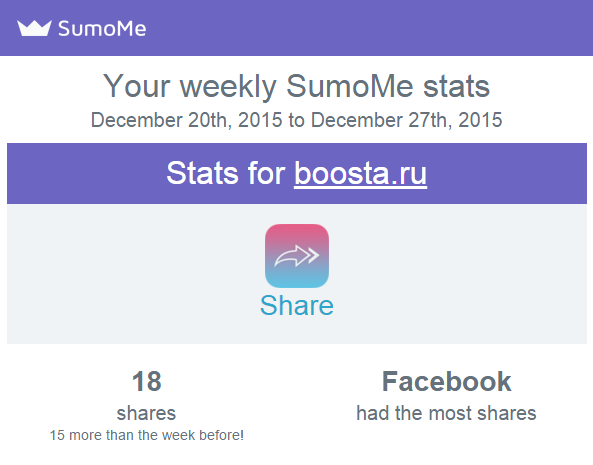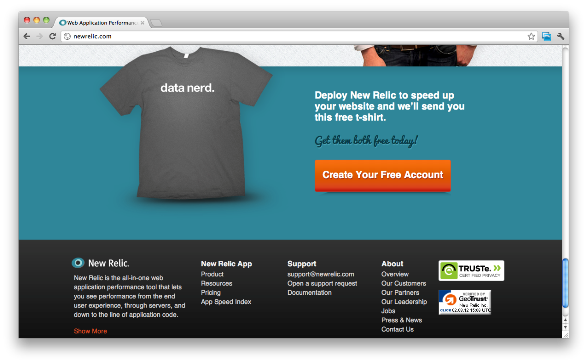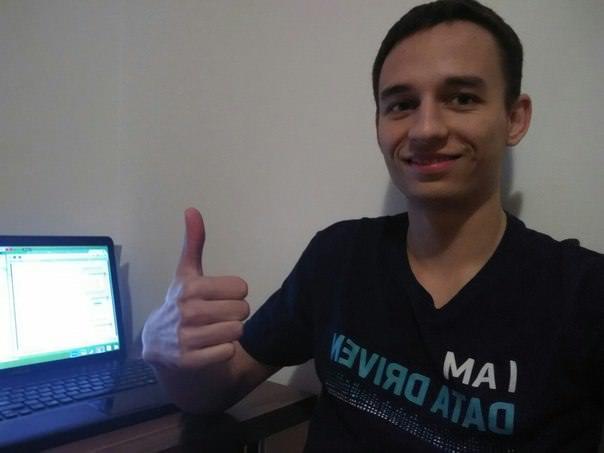Growth Hacking: 36 Real-Time Cases - Part 1

We analyze how Exclusivity hack works with examples of Google, Ello, Quibb, how Facebook uses e-mail notifications to engage users and how to distribute things intelligently for free to activate potential customers.
Email notifications on Facebook
What did : Facebook by e-mail every time notifying users that someone marked it in the photo.
')
Result: CTR (Percentage of visits to the site) was approximately 75%
What it was done for: A key indicator for Facebook is holding. The more often users use a social network, the more time they spend on it, the better. E-mail notification of any action is one of the ways to attract the user's attention and return it to the site.
As the result shows, people were very interested in who and in what photo marked them. Therefore, 3 of 4 users went to the site. This is a really high figure. I think that due to this hack, Facebook was able to significantly increase user involvement.
By the way, similar hacks are used by other social networks. For example, Twitter notifies about your account references, retweets, likes and new subscribers. All this is done in order to remind yourself, show value and engage you.
But how SumoMe service reminds of itself and shows its value:

Do you think it's nice for me to receive a letter once a week, where all the information about my pop-ups for collecting subscribers is collected?
I really love these letters. They carry value for me - show that the service really works and constantly brings new subscribers. On the other hand, this is a very unobtrusive reminder of yourself, which “strengthens” our relationship - the relationship between a client and a company.
If you want to use such a hack in your project, then you need to think about what is important to your users and periodically notify them about it. If it would be useful for them, then such a step would prove to be efficient in terms of engaging and retaining users.
Article in topic - Bleed E-mail marketing: trigger mailings
Exclusivity hack from Google, Ello and Quibb
When Google launched beta testing of the Gmail service in 2004, he used the principle of exclusivity - it was possible to become a user of the service only by invitation. The one who received the invitation was given the opportunity to invite another person. This created a stir, the hype around the service. And each user who received the invitation, felt like a member of the VIP club. After all, this is what the guys from Google wanted. And they did it all.
They used one of the principles of the psychology of persuasion - the principle of scarcity . Robert Cialdini in his book "The Psychology of Persuasion" described it this way: "Goods seem more attractive when it is known that their quantity is limited." As a product - a service. As a limitation, access is by invitation only. Human nature is such that even if we did not need this access, then under such a condition many people have this feeling. As a result - an incredible increase in users.
I can not describe one very funny fact. Around the launch of Gmail there was such a stir that invitations began to sell even on Ebay. Lots cost from $ 65 to $ 125. Up to 20 people participated in the fight for some invitations. In my opinion, this is a very indicative example of how effectively Google has applied this hack.

By the way, maybe Google employees themselves started selling tickets, and buying them themselves in order to attract additional press attention? I think it is quite possible. Another way to PR and create hype around the launch. Growth hack, so to speak.
Exclusivity hack is used not only by such large corporations as Google. We can recall the startup Ello - a closed social network without advertising. You can get into it only at the invitation of a registered user. Each user is given 25 invitations. After the launch of the social network, 35,000 invitations were sent every hour.
Using this hack, you can replace paid channels to attract users. If people see value in your project, then they themselves will strive to get into a closed society. And having received the invitation, they will invite their friends so that they will not be lonely there. After all, it is obvious that we will not use the social network if there are no our friends, acquaintances, colleagues or other persons in whom we are interested. This is how the viral user growth mechanism starts.
Quibb - professional social network also uses this hack. On the main page of the site, they openly say that this is a closed social network, where each application for entry is analyzed manually and only 41% of users get approval.

Let's think about this tactic together.
So, "closed social network" - stands out among all standard social networks. Perhaps there is something interesting, inaccessible to all users.
“Each application is reviewed manually” - strict selection ... Surely, only the best ones get into it. We must apply, because I have to go there.
"Only 41% of users get approval" - another factor of exclusivity, which pushes us to register in it.
So, we have considered the exclusivity factor that is used by companies such as Google, Ello, Quibb. Surely, many others use this technique, but we just do not know about it.
Think about how you can do this in your own home. Suddenly this particular hack will help “fly up” to your project.
Moving on.
Article article - These [17 bugs] "bury" your A / B test
Waiting list
In the first article about Growth Hacking, I described how Mailbox used this hack and was able to attract 700,000 users in the first week after launch. To attract visitors to the site, they used powerful PR and opinion leaders. But at the second stage, the most interesting part began - the process of converting visitors into registered users.
At this stage, they used a waiting list (Waiting list), that is, they showed how many users have already left their contact information and are waiting for the service to start. After registration, each user was assigned a specific number in the queue. By the way, then Dropbox bought Mailbox for $ 100 million.

It's very simple, right? But how often do you see how other companies use this hack? I very rarely encounter this, only on foreign sites, where companies use all the possibilities in the struggle for users.
The same strategy was used by Clinkle (which attracted more than $ 30 million from investors in Silicon Valley). Clinkle is a payment platform that improves the process of payment for goods / services (as written on the Crunchbase website)
At the beta stage, the site was used only for one purpose - to receive an E-mail address. The guys from Clinkle used the same tactics as the Mailbox. Next to the contact form was information about how many users are already in the queue.
In addition, users were asked to climb higher in the queue. But for this it was necessary to make several additional actions - for example, repost in social networks. This was another important factor in the rapid growth of the company. When users did a repost, the viral mechanism was launched, and with each repost more and more people learned about this service.
Article in the topic - Case: Increase of registrations by 11.6% in the service Piktochart
Integration with large sites
Surely, everyone has already heard about the integration between Airbnb and Craiglist (this is the most hackneyed example). It was from this group of hacks that the company's rapid growth began. But not only Airbnb used the capabilities of larger companies.
So, Spotify, a service for listening to music, used Facebook. The integration was as follows: each time a user included a song in Spotify, the name of the song and the link in Spotify were shown in the user's news feed.

Friends saw this information, and some of them followed the link to Spotify, after which they registered and became regular users.
By the way, the principle of social proof worked here (which is also described in Robert Cialdini’s book Psychology of Persuasion). The essence of this principle is that we trust our friends, colleagues, and acquaintances with much greater confidence than standard advertising and calls from strangers.
The main essence of this hack is that you need to look for opportunities on the side, on larger platforms, where your target audience is. Perhaps this will be a free and effective source of customers.
Article in the topic - How to increase conversion - 30 short tips for internet marketers
Registration gifts
Personally, I saw how this hack was used by New Relic, Trak.io, Invision. For registration in their services, they handed out T-shirts with their own print - company name and logo. People love freebies - this is a known fact. And it can be used for your own purposes - to grow your customer base.
But there is also a reverse side of the coin. This may result in people registering only for freebies, and not for using the service. Then this hack can turn into continuous losses and into the formation of a poor-quality user base.
Therefore, it is very difficult to assess how effective this technique is in terms of the quality of users. But these 3 companies have been using it for quite some time. And, I think that they would hardly have been doing it for so long if it were unprofitable.
In any case, thanks to this, you can get the contact information of the user. And, if he has already entered the site (not behind the T-shirt, but simply because he has found out about him somewhere), then at least he has the slightest interest in the service. And after receiving the contact information, you can start the activation process, involving users.
For example, if we consider the Invision case separately, then they play a jersey only because the person subscribes to the company's newsletter. This option can lead to the flow of poor-quality leads.
New Relic uses this smarter hack. Mike is given only to those who install the service code on their website. Now think about why this particular action is required?

Most likely, the installation of the code on the site is the main target action in the service. And it is through this action that the user is activated - after installing the code, he can “feel” the value of the service. This is a very logical scheme. The person feels the value of the service, after which he becomes a regular user. And the shirt is just a nice addition.
Let me give you another example that I encountered personally. MixPanel is a great web analytics service. Some time ago I registered in it, but it was not “activated”. I successfully forgot about him. After a week or two, I received a letter inviting me to get a free T-shirt with the words “I am Data Driven” in exchange for installing two events (events like in Google Analytics) on my website.

It was hard to refuse such an offer. Mike was smart, and there was an incentive to broach in the cool service. Of course, after 10 minutes I put the service code on the site, created two events and passed them to MixPanel. Two weeks later, the shirt was in my mailbox, and now I enjoy it - it is really cool. So just happened the first contact between the service and the average user. But! Now I am a loyal user. I use their service, analyze sales funnels in it, conduct cohort analysis and just enjoy it.

Naturally, not every company can use this hack. For this you need an extra budget (although in large numbers such T-shirts with a simple print cost a couple of bucks, no more). And here it is necessary to compare how much it costs to attract a registered user through other channels. If the t-shirt t-shirt is cheaper (which is quite possible considering how quickly the cost of attracting users is rising), then why not try it?
The following articles will be the second batch of successful grow hacks. Do not miss.
By the way, if you want to receive your hack on your mail every day, then here is your invitation to the closed online community GrowthHackingIdea.com
Article prepared the site Boosta.ru - a resource about Internet marketing
Read also our other popular articles:
1. How to increase conversion - 30 short tips for [internet marketers] (3000+ views)
2. They will help you find all the “killers” of the conversion - 10 reports in Google Analytics (5000+ views)
3. 100 ideas for A / B testing. Part One (2000+ views)
4. 100 ideas for A / B testing: Part Two (1000+ views)
5. How to find an idea for an A / B test: heat maps and polls (1000+ views)
Source: https://habr.com/ru/post/297762/
All Articles